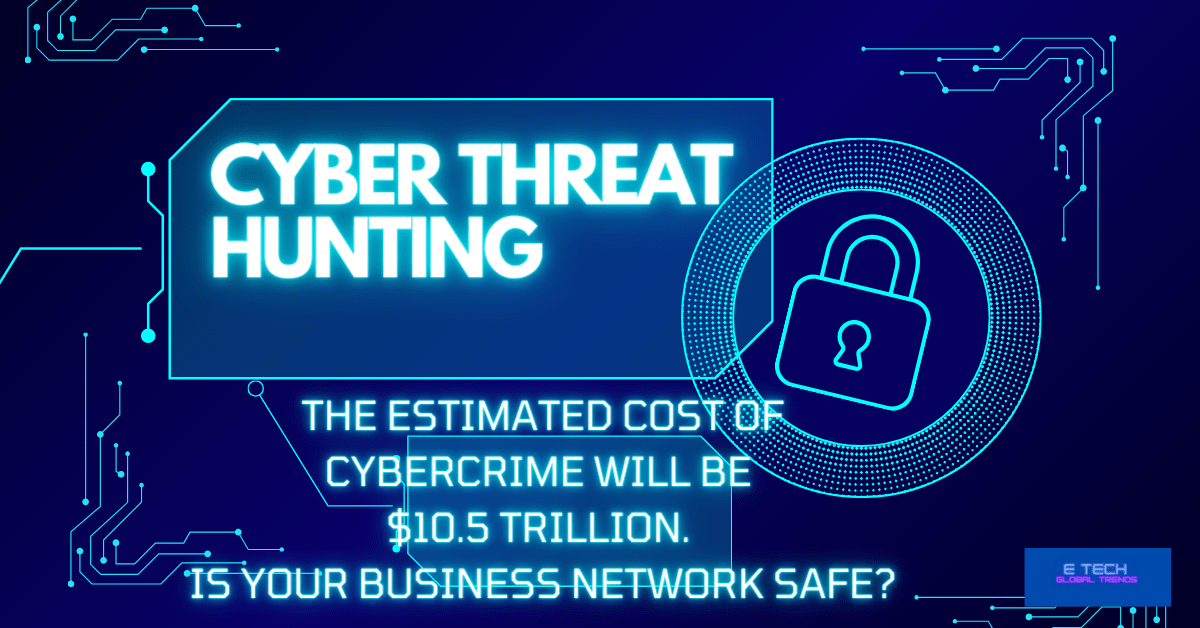Cyber Threat Hunting
Last year alone saw a 61% increase in phishing assaults. Furthermore, by 2025, the estimated cost of cybercrime will be $10.5 trillion. Is your business network safe? well, nothing is fully safe on the internet. But it’s your responsibility to take secure actions. Well, let’s jump into “Cyber Threat Hunting” as a highly important insight.
What is Cyber threat hunting?
The process of aggressively investigating a network for hidden cyber threats is known as “threat hunting.” Cyber threat hunting searches far and wide for bad actors in your system that have eluded your first line of protection when it comes to endpoint security. As businesses look to keep ahead of emerging cyber threats and quickly address any possible assaults, threat hunting is growing more and more crucial.
The proactive practice of looking through datasets, networks, and endpoints to find and isolate sophisticated threats that elude detection by current security solutions is known as “threat hunting.”
Threat hunting is actively looking for prospective dangers that could be hiding within an organization’s IT environment and not being noticed, in contrast to standard security procedures that respond to recognized threats.
Why It’s Important to Threat Hunt?
Detects Advanced Threats.
Threat hunting assists in locating complex cyber threats that typical security tools overlook,
such as;
- persistent advanced threats (APTs) and
- zero-day vulnerabilities.
Enhances Security Posture.
By locating and fixing vulnerabilities before attackers can take advantage of them, threat hunting improves an organization’s overall security posture.
Enhances Incident Response.
By offering insightful information and context, threat hunting enhances the efficacy and efficiency of incident response operations. It makes it easier for security professionals to react to any threats more swiftly and precisely.
Compliance & Risk Management.
Preemptively detecting and reducing hazards aids in controlling cybersecurity risks and promotes regulatory compliance, both of which are essential for safeguarding sensitive data and upholding stakeholder confidence.
Boosts Threat Intelligence.
Consistent threat-hunting efforts help businesses get a deeper comprehension of the threat environment, which enables them to continually update and improve their security protocols.
Cuts Down on Dwell Time.
Organizations may cut down on the amount of time a danger stays unnoticed in a network by continually looking for risks. This reduces the effect and any harm from a breach.
Are you ready to protect before a cyber threat arrives?
Of course, it is a vice action. For this reason, 69% of businesses want to boost their cybersecurity infrastructure spending.
using a proactive strategy to detect and eliminate cyber threats that have eluded conventional security procedures. It entails proactively scanning networks, endpoints, & datasets with a combination of automated technologies and manual procedures to find and isolate sophisticated attacks that might not have raised any alarms. To keep up with sophisticated attackers and improve their overall cybersecurity posture, firms must engage in cyber threat hunting.
Why do companies have to be prepared before cyber threats arrive?
A proactive cybersecurity technique called “cyber threat hunting” aims to spot dangers before they materialize.
To be more precise, the method entails proactively scanning a network of a business for indications of hostile behavior or possible security breaches.
Cyber threat hunting, according to over 85% of enterprises, has increased overall security.
Additionally, since 93% of firms want to increase expenditure in cyber threat hunting, interest in this technique is anticipated to continue to rise.
Why is network threat hunting crucial for online safety?
The ability to actively identify and mitigate possible attacks before they harm makes network threat hunting essential to cybersecurity. Threat hunters find hidden risks that automated systems might overlook by actively looking for indications of malicious activity across a network. This proactive strategy lessens the impact of security events, lowers the possibility of successful breaches, and protects sensitive data and important assets for enterprises.
How does threat hunting fit into the offensive security model?
While you are sleeping “they” aren’t.
In the digital realm, threat hunting is akin to hide-and-seek. To stop hidden dangers from causing damage in a network, cybersecurity specialists might use this method to actively search for them.
Think of the cyberthreats as burglars, and your network as a house. Now, some really adept thieves (hackers) can still be able to break in even if you have the greatest locks (security measures). Threat hunting is similar to keeping a security guard that actively searches every area (or section of your network) for potential intruders (threats) and doesn’t just rely on alerts.
Threat hunting is essential to proactive security, which is similar to fighting thieves rather than merely providing cover. It assists in locating intruders, enabling you to expel them and improve the security of your home going forward.
Does this work well?
Well, this is how it happens.
Aggressive defense By taking a proactive and responsive stance, cybersecurity plays a critical role in reducing the impact of contemporary cyber threats. It uses techniques to identify and neutralize possible threats,
including;
- threat intelligence,
- honeypots, &
- deception technologies.
Security teams can find hidden risks that standard security measures might overlook by actively monitoring and doing threat hunting. Automating and orchestrating reactions to threats helps to quickly block or control them.
Furthermore, by granting access based on ongoing verification, a Zero-Trust design guarantees that nobody is trusted by default. Employee education and awareness initiatives aid in identifying and reporting questionable activity, and cooperative efforts to exchange threat intelligence fortify overall security postures. Combining these strategies allows active defensive cybersecurity to adjust to the ever-changing threat landscape, assisting businesses in lessening the impact of contemporary cyber threats and successfully protecting their digital assets.
Let’s check on the real practical issues. The most important thing is this task(Cyber Threat Hunting) is not an easy game!
check why we say that…
What tools and knowledge are required to defend against sophisticated cyberattacks?
Sophisticated cyberattacks must be defended against using a mix of advanced technology and specialized understanding. Robust cybersecurity technologies encompass advanced threat intelligence platforms, intrusion detection systems, and endpoint protection platforms.
Cybersecurity experts with backgrounds in digital forensics, incident response, and threat hunting are essential for efficiently identifying and mitigating sophisticated cyber threats. Proactive cybersecurity measures, knowledge, and technology must collaborate to stay ahead of the constantly changing landscape of cyber threats.
what is the cost for Cyber Threat Hunting and is it value for a business network?
Yes, but it will depend on mainly 2 facts.
They are…
Internal team
It might be costly to hire qualified experts to assemble your danger-hunting team. Additionally, you’ll need to spend money on team training and security equipment purchases. The annual cost for this can range from $200,000 to $2.5 million depending on the network’s complexity and scale.
Threat hunting services
They are provided by managed service providers (MSPs) as a component of larger security packages. For smaller enterprises, this might be a more economical choice. Concerning the service provider, costs might range from $30,000 a month for a set amount of hunting time to a retainer agreement. Right?
Is it worthwhile, then?
Cyber threat hunting’s usefulness for your company will rely on many points.
Network’s size and complexity.
Risks are higher for larger, more sensitive networks, which may make threat hunting more beneficial.
Your budget for security
You should balance the possible advantages of threat hunting against its possible expense.
Your risk tolerance.
Threat hunting might be a wise investment if your company is particularly vulnerable to data breaches.
So, as you read, finally Cyber Threat Hunting will become a “cannot afford”?
And the 2nd part of this question has been discussed before. So in other words…
Benefits to the Business Network
Here are some reasons why your company network may benefit from cyber threat hunting.
Proactive security
It surpasses conventional security methods that depend on identifying threats that have already been identified. Threat hunting is the aggressive pursuit of possible security lapses and covert attackers.
Early threat detection and prevention.
This can help you stop attacks before they have a chance to seriously harm your network and data.
Enhanced security posture
By regularly searching for threats, you may find gaps in the strength of your defenses and strengthen your security posture as a whole.
Summary
The Cyber Threat Hunting is fine and costly. But it’s a highly advanced technique for businessmen. Cyber threat hunting is a useful tool that companies of all kinds may use.
The price, nevertheless, might differ greatly. Think carefully about your budget and unique requirements before determining if this is the best choice for your business.
when for an enterprise cyber security is crucial, then make a decision positively.
Hope this content helps.
Cheers!
Read more on related topics here. Cybersecurity tools, penetration testing device







